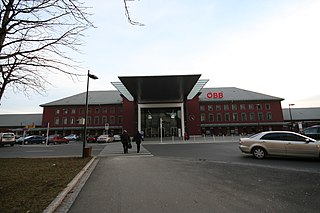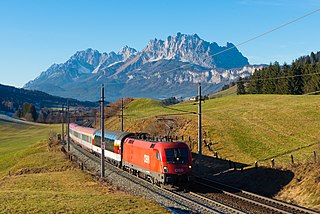
München Ost is a railway station in Munich, the state capital of Bavaria, Germany. It opened as Haidhausen station in 1871 on the new Munich–Mühldorf and Munich–Rosenheim railway lines. The station is operated by DB Station&Service, a subsidiary of Deutsche Bahn AG, and is classified as a Category 1 station, one of 21 in Germany and two in Munich, the other being München Hauptbahnhof. It is the city's third interregional station besides München Hauptbahnhof in the city centre and München-Pasing in the west.

Straßwalchen is a market town in the district of Salzburg-Umgebung (Flachgau) in the state of Salzburg in Austria.

Railjet is a high-speed rail service in Europe operated by Austrian Federal Railways (ÖBB) and Czech Railways (ČD). It was introduced with the timetable change of 2008–2009 and operates at speeds of up to 230 km/h (143 mph). Railjet is ÖBB's premier service and operates both domestically within Austria and on international services to adjacent major cities in the Czech Republic, Germany, Switzerland, Italy, Hungary and Slovakia.

Innsbruck Hauptbahnhof is the main railway station in Innsbruck, the capital city of the Austrian federal state of Tyrol. Opened in 1853, it is one of the country's busiest railway stations with around 25,000 passenger movements daily.

Rosenheim station is the main railway station in the city of Rosenheim in Bavaria, Germany. It is the seventh largest passenger station in Bavaria and an important railway hub between the Munich–Rosenheim railway line and the lines to Salzburg, Kufstein/Innsbruck and Mühldorf, as well as the Mangfall Valley Railway. Rosenheim is operated by DB Station&Service, a subsidiary of Deutsche Bahn AG, and is classified as a Category 2 station

The Rosenheim–Kufstein railway is a 32 kilometre-long double-track main line of the German railways. It connects the Munich–Rosenheim and the Rosenheim–Salzburg lines at Rosenheim with the line to Innsbruck, thus connecting Germany, Salzburg and eastern Austria with Innsbruck and the Brenner line to Italy and the Arlberg line to far western Austria. The line is part of the Line 1 of Trans-European Transport Networks (TEN-T). It is electrified at 15 kV, 16.7 Hz.

The Munich–Rosenheim railway is a 65 kilometre-long double-track main line of the German railways. It connects Munich Hauptbahnhof with Rosenheim station, where it connects with the Rosenheim–Salzburg railway, which connects with the line to Vienna at Salzburg, and the line to Kufstein, which continues to Innsbruck and the Brenner line to Italy. The line is part of the "Main line for Europe", connecting Paris with Bratislava and Budapest and the almost identical line 17 of Trans-European Transport Networks (TEN-T). It is part of the line 1 of TEN-T. It is electrified at 15 kV, 16.7 Hz. It was opened between Munich and Rosenheim in 1871.

Villach Hauptbahnhof is the main railway station in Villach, the second largest city in the Austrian state of Carinthia. It primarily serves as a passenger station and is an important junction within the Austrian Federal Railways (ÖBB) network.

Linz Hauptbahnhof or Linz Central Station is a railway station in Linz, the third largest city in Austria, and capital city of the federal state of Upper Austria. Opened in 1858, the station is the centrepiece of the Linz transport hub. It forms part of the Western Railway, and is also a terminus of the Pyhrn Railway, the Summerauer Railway, and the Linzer Lokalbahn (LILO). The station is owned by the Austrian Federal Railways (ÖBB); train services are operated by the ÖBB and the LILO. With over 30,000 travellers per day, it is one of the busiest through stations in Austria.

Wels Hauptbahnhof, occasionally Wels Central Station or Wels central station is a railway station at Wels, which is the second largest city in the federal state of Upper Austria, in the north of Austria.

St. Pölten Hauptbahnhof is the main railway station at St. Pölten, which is the capital city of the federal state of Lower Austria, located in the north east of Austria. The station is one of the western endpoints of the Verkehrsverbund Ost-Region.

Wörgl Hauptbahnhof is the main railway station of Wörgl, a city in the Kufstein district of the Austrian federal state of Tyrol, about 20 km from the state border with Bavaria. It is a major hub for regional and international rail travel, both passenger and freight.

Klagenfurt Hauptbahnhof is the main railway station in Klagenfurt, capital of the Austrian state of Carinthia. It is an important railway junction in southern Austria.
The Western Railway is a two-track, partly four-track, electrified railway line in Austria that runs from Vienna to Salzburg via St. Pölten and Linz Hauptbahnhof and is one of the major lines of Austria. It was originally opened as the Empress Elisabeth Railway in 1858 (Vienna–Linz). The line is owned and operated by Austrian Federal Railways (ÖBB).

The Salzburg-Tyrol Railway is a main line railway in Austria. It runs through the states of Salzburg and Tyrol from the city of Salzburg to Wörgl and belongs to the core network (Kernnetz) of the Austrian Federal Railways (ÖBB). The section between Salzburg and Schwarzach-Sankt Veit is part of the Salzburg S-Bahn urban railway network.
The Wels–Passau railway—also called the Passauer Bahn in German—is a two-track, electrified main line railway mainly in Austria, which was originally owned and operated by the k.k. privilegierte Kaiserin Elisabeth-Bahn company. It runs from Wels in Upper Austria to Passau in Bavaria and is part of the core network of the Austrian Federal Railways.
The Rosenheim–Salzburg railway is a continuous double track and electrified main line railway almost entirely within the German state of Bavaria. It is an international transport corridor, linking Rosenheim to Salzburg in Austria.

The Transalpin is a EuroCity express train linking Zürich (Switzerland) with Graz (Austria) via Liechtenstein. Introduced in 2013, it is operated by the Austrian Federal Railways (ÖBB) and the Swiss Federal Railways (SBB-CFF-FFS). From 1958 to 2010 a train of the same name linked Basel or Zürich with Vienna.

Vienna Airport is a railway station serving Vienna International Airport in Schwechat, Lower Austria, Austria. The train services are operated by ÖBB and Deutsche Bahn.

The Rudolf Railway refers to a railway connecting Amstetten and the Italian border near Tarvisio, along with a branch from Kastenreith to St. Valentine. Its name is derived from the k.k. priv. Kronprinz Rudolf-Bahn Gesellschaft. The main line, which was opened from 1868 to 1873, ran on the St. Valentin–Kastenreith–Kleinreifling–Selzthal–Schoberpass–St. Michael–Neumarkt saddle–St. Veit an der Glan–Feldkirchen in Kärnten–Villach–Tarvisio Centrale route. The section of the line within the current borders of Italy now runs over the new Tarvisio–Udine railway through Tarvisio Boscoverde. It replaced a very windy route to Udine that originally formed part of the Rudolf Railway.


















